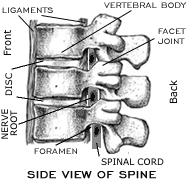 Health
Health
 Back Pain and Injuries
Back Pain and Injuries

See Symptoms - Cause - Remedy and treatment for more detail.
Anatomy
From: ANATOMY OF THE SPINE at Obus Forme (web link no longer available)  The SPINE is one of the strongest parts of your body. A healthy spine is flexible and pain-free. It supports the weight of your body, allows you to move with ease and protects the spinal cord.
The SPINE is one of the strongest parts of your body. A healthy spine is flexible and pain-free. It supports the weight of your body, allows you to move with ease and protects the spinal cord.
The spine is made up of 24 true VERTEBRAE (singular = vertebra). These are divided into 3 regions: CERVICAL SPINE (neck) - 7 mobile vertebrae; THORACIC SPINE (upper back) - 12 mobile vertebrae; LUMBAR SPINE (lower back) - 5 mobile vertebrae. There are also 2 composite vertebrae called the SACRUM (5 fused vertebrae), and the COCCYX or TAILBONE (4 fused vertebrae). Vertebrae are stacked one on top of the other. They extend from the base of the skull to the coccyx. Vertebrae fit together to form the three basic curves of the upright spine, The first 7 vertebrae (CERVICAL SPINE) curve forward to form the CERVICAL LORDOSIS. The next 12 vertebrae (THORACIC SPINE) curve backwards to form the THORACIC KYPHOSIS. The last 5 vertebrae (LUMBAR SPINE) curve forward to form the LUMBAR LORDOSIS. These curves must be balanced to allow us to stand upright without effort or pain. Each vertebra is linked to the next by a pair of joints called FACET JOINTS. These joints help to stabilize the spine and guide its movement. They are similar in design to other joints in the body. |
|
LIGAMENTS are strong rope-like fibers that bind vertebrae together and stabilize the spine during movement. |
 MUSCLES provide the power for movement and help stabilize the spine. Abdominal muscles are especially important during lifting to protect the spine from injury. They also help to maintain proper posture.
MUSCLES provide the power for movement and help stabilize the spine. Abdominal muscles are especially important during lifting to protect the spine from injury. They also help to maintain proper posture.
The SPINAL CORD runs through a hole in the center of each vertebra called the SPINAL CANAL. The spinal cord consists of all the nerve fibers that connect to our brain. These nerves allow us to move and to feel. The spinal cord fills 95% of the spinal column at the cervical vertebrae, but only 60% at the lumbar. |

There are small openings on each side of the vertebra called FORAMINA (singular = FORAMEN). These openings provide a tunnel for the SPINAL NERVES that come from the spinal cord and travel to all parts of the body. The sensory (cutaneous) nerves leave the spinal cord in the dorsal root (posterior root) and the motor (muscle) leave in the ventral root (anterior root). Pain nerves emerge from the opposite side, while light touch and motor nerve roots are on the same side. |
 Each vertebra is separated by a DISC. The disc contains an inner gel-like material (NUCLEUS PULPOSIS) surrounded by an outer layer of elastic material (ANNULUS FIBROSIS). Discs help absorb the shock of the thousands of jolts and strains your back must endure every day. SOURCES OF PAIN - OVERVIEW Injuries to the muscles and ligaments are commonly called SOFT TISSUE INJURIES or MYOFASCIAL STRAINS. "Whiplash" is a common term used to describe soft tissue injuries in the neck. Back or neck pain caused by soft tissue injuries is usually due to muscle spasm. Irritation of the FACET JOINTS from poor posture and other daily stresses is a common source of back pain. Severe pain can result from a DISC HERNIATION. This is due to a tear in the outer annulus. This tear allows the nucleus to expand and press against a nerve. This pressure causes pain, numbness and weakness in the arm (CERVICAL DISC HERNIATION) or leg (LUMBAR DISC HERNIATION). Most people (90%) who suffer a disc herniation will recover without surgery. |
Other
Pain Management in HealthImprove your posture
Symptoms - Cause - Remedy
Neuroanatomy in Science
Beating Back Pain - Consumer Reports Video
Load on the Back
Ergonomic Furniture, beds, back rests designed for Back Pain Relief
Compression Fractures
Exercises
The Perfect Sleeping Positions to Fix Common Body Problems
Return to Health.